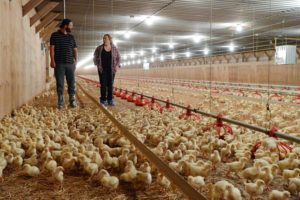 Chicken Housing
Chicken Housing
Wondering why chickens are sometimes kept in cages? Deciding on the best type of housing for chickens is complex and there are many factors that farmers take into account.
Are all chickens kept in cages?
Chickens that are raised for meat are kept in free-run indoor systems where they can move around freely along the barn floor, or are free-range with access to the outdoors, as well as indoor protection from weather and predators.
Hens that lay eggs and breeding hens that produce chicks for commercial egg or meat production are the only chickens housed in cages. Farmers use a variety of cage and non-cage housing systems for laying and breeding hens.
What does Chicken Behaviour have to do with the houses they live in?
Modern hens are descendants of jungle fowl and naturally prefer to live in small spaces with a small number of birds. Birds have hierarchies in which dominant hens can become aggressive towards other hens outside their group. Cages for laying hens were developed to reduce disease and injuries due to pecking, as well as ensure more consistent egg production. Cages are evolving though and many farmers are switching to enriched housing, furnished with dust baths, perches and nest boxes.
See Our PDF to Learn More: DownloadPrint
SnapAg:
What are GMOs and are they okay to eat? What does organic farming look like? How are animals like chickens or cattle raised?
snapAG is a series of resources that invite students to explore the hot topics affecting the agriculture industry today. Topics range from organics, biotechnology, GMOs, livestock, and more.
Explore what’s trending in agriculture in Canada by browsing the topics here.
Sources available at: https://aitc-canada.ca/en-ca/learn-about-agriculture
snapAg is brought to you by Agriculture in the Classroom Canada and partners.



